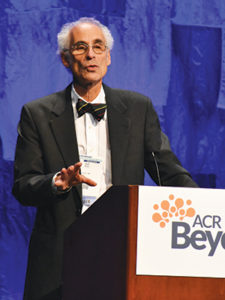
Emerging evidence supports the hypothesis that the skeleton mediates whole body metabolism, particularly targeting the adipocyte. On the other hand, adiposity is a pathogenic factor in osteoarthritis (OA) and may impact osteoporosis risk.
The central role of the adipocyte in the pathogenesis and treatment of osteoporosis was the focus of this year’s Oscar S. Gluck, MD Memorial Lecture, Osteoporosis: Should Rheumatologists Worry About Adipocytes, by Clifford J. Rosen, MD, Senior Scientist and Director of the Center for Clinical & Translational Research at the Maine Medical Center Research Institute.
“New and emerging research is providing important insights into why obesity is such an important pathogenic factor for both osteoporosis and osteoarthritis,” Dr. Rosen said on Sunday afternoon. “Most people think of obesity in osteoarthritis as being purely a weight phenomenon, with loading on the joints as the contributor, and in osteoporosis, people have traditionally thought of being heavy and overweight as being protective of the skeleton. In fact, both of those conditions are made worse by obesity.”
While obesity is not a high-grade inflammatory condition, such as rheumatoid arthritis, it is reminiscent of OA, Dr. Rosen said.
“Obesity is very similar and leads us to understand a little more clearly why approximately two-thirds of all OA patients have either high BMI or obesity,” he said. “Obesity is a low-grade chronic inflammation, possibly due to changes in the gut microbiome with subsequent paracrine and endocrine actions on bone and joints. But to understand that process, one has to appreciate that not all adipocytes are the same. There are a number of different adipocytes and they depend primarily on the location of the fat cell.”
The two phenotypes most often associated with clinical disorders or aging, he said, are the pear-shaped phenotype that is primarily defined by increases in subcutaneous fat and the apple phenotype, which is visceral adiposity.
“There is also a third type of adipocyte that is called a beige, or brown, adipocyte,” Dr. Rosen said. “We now believe that there is fourth type of adipocyte that really provides that window into the pathogenesis of osteoporosis and what is happening in the bone marrow, and that is the marrow adipocyte.”
Most fat cells can be divided into two functional characteristics, he said, either brown and beige adipocytes or white adipocytes.
“The white adipocyte is involved in the storage of fat, and while it’s generally not very metabolically active, it does secrete adipokines and cytokines that may be potentially important,” Dr. Rosen said. “Fatty acid oxidation is present in these cells, and it is inducible, but it’s not very common. In fact, the white adipocyte is generally used as a storage mechanism for excess triglycerides.”
The brown adipocyte is found in the interscapular region of infants and is the protective device for infants born in an environment that is not warm, he said, because it’s a thermogenic mechanism that protects the body from shivering thermogenesis.
“Beige adipocytes are brown-like and are present in the subcutaneous adipose depot and those can be inducible with cold or with certain drugs,” Dr. Rosen said. “One of the biggest pharmacologic thrusts over the past five years is to make white adipocytes into beige adipocytes or to enhance the characteristic beige phenotype in order to burn fat rather than store it.”
The most important phenotype that rheumatologists should be worried about is visceral adiposity, he said, not only because it has real significance in terms of cardiovascular risk, but also because it is an inflammatory condition.
“It’s a low-grade inflammation that occurs as the adipocytes begin to store more and more fat,” Dr. Rosen said. “At the same time that they are storing fat, they are also inducing a macrophage response, and that macrophage response begins a cyclic process signaling the neighboring adipocyte to release adipokines that may be detrimental not only to the fat cell itself, but also to other tissues.”
As research continues to advance the understanding of the pathophysiology of obesity and its impact on osteoporosis and osteoarthritis, Dr. Rosen said, novel therapies that target the adipocyte might have future implications for the rheumatologist.
“Pay attention to obesity as an inflammatory condition in patients you see with osteoporosis and osteoarthritis,” he said. “And consider targeting primary interventions, such as gastric bypass or exercise, towards treating the obesity as much as treating the joint or the bone itself.”
